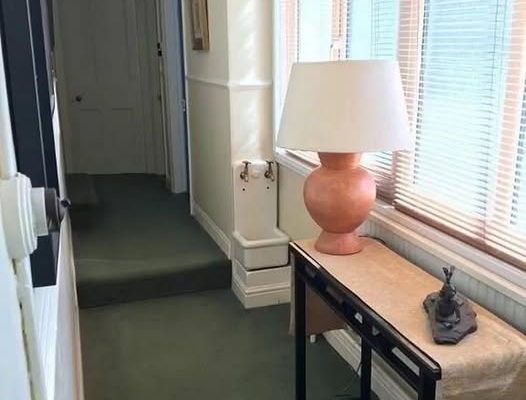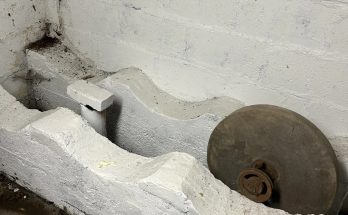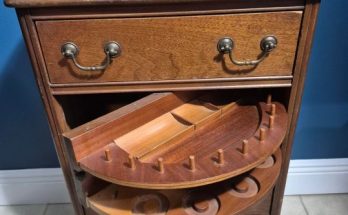You know those old homes that make you feel like the floor is going to swallow your keys if you drop them? And you’re walking in a dark hallway, there’s a weird draft from who knows where, and then—boom—tiny sink just appears? Not in a bathroom or anywhere near where you’d expect it, just neatly hanging out in your hallway. I remember the first time I saw one, I thought it was soooo weird.
Honestly, who puts a sink there? It almost felt like that sink somehow got put in time-out because the bathroom was too full. I just happened to see a ridiculous photo on Reddit of one of these sinks just chilling out in a hallway as ridiculous as could be! The guesses from people in the comments were priceless! One person thought it was a foot washer, another thought it was some fancy spittoon, some thought it was a plumbing fail and nobody bothered to fix it!
Nope, not a fail. The awkward little hallway sink actually served a purpose. A real purpose. I had to dig around a bit to figure it out, but it’s actually pretty cool once you understand it.
Hallways Back When Hallways Mattered
So let’s take a mental trip back to the early 1900s—before we had powder rooms, before every house had at least one bathroom on every floor. Back in the day, if you had indoor plumbing (which was rare), you had only one bathroom that was probably in an odd location. It was inconvenient to have to go upstairs just to wash your hands. Staircases weren’t built to any safety laws, and they were steep.
Hallways didn’t mean “hey I just want to get from point A to point B”. Hallways were places to take off boots, possibly drop off your hat, and stand there talking to someone for half an hour (again, apparently leaving is a twenty-minute process). They could be a busy place.
Given that, it made perfect sense to squeeze in a little sink. When it became necessary to wash your hands/face (dusty street? going into the dining room?), just go to the hallway and use the hallway sink. Problem solving without making everyone march upstairs.
HYGIENE?
This was a time when germ theory started making sense to people. Before this point people would think, “eh dirt builds character.” Fast forward, people thought washing your hands before dinner made sense. Now let me tell you, these bathrooms were few and far between, and in any case kitchens were quite busy places. Thus, the hallway sink was born!
It wasn’t designed for luxury, it was designed for function; you could wash your hands without interrupting the whole household. Particularly with guests. You think anyone wants a bunch of strangers wandering into bedrooms just to go wash hands and faces?
Funny and Small, but Served a Purpose
Some of these hallway sinks are so small, it is almost comical. I’ve seen a couple of sinks out there that were barely big enough to wash an apple—never mind your hands. But that’s all they needed. They weren’t for bathing or filling up buckets, just a quick wash.
I guess they had that classic two-tap, hot and cold (how long did that take to balance so you didn’t take your skin off)—but it did the trick. And it kept people from accessing that city grime straight to the dinner table.
Better than a single bathroom.
It’s got me thinking—if you’ve ever thrown a party in a house with one bathroom, you know what sort of chaos that gets. People lining up knocking every two minutes to ask “are you done yet?” Imagine if you had a hallway sink. You could just wash up there—no line, no deliberate awkward bathroom time.
And that’s basically what these old houses were built for: life without today’s conveniences of having to buy a bathroom with every bedroom. That forced them to be clever, and alright, it looks weird now, but I mean, it was clever then.
Because people get it wrong now.
Nowadays, we see a sink in a hallway and immediately think someone went offscript with the blueprints. Or it’s like, a DIY gone wrong. And truthfully, can’t blame anyone for that. We live in a world full of powder rooms or half-baths everywhere we turn.
And it’s easy to forget that there was a time in our not-too-distant past when it wasn’t simple or private to wash your hands. So when people online speculate it’s for dogs, shoes, or some old time-y ritual, that’s a good reminder on how far we’ve come, but the sinks? Straightforward hand-washing stations. Nothing more.
They’re Still Useful (I mean it)
If you have one of these still in your home, do not take it out. Seriously, I mean if you absolutely hate it, take it out, but think about it: you have a basically extra sink, where you can wash your hands without running to the bathroom. It isn’t dead weight. And a conversation piece!
“Hey, why do you have a sink in your hallway?”
“Oh, let me tell you about early 20th-century hygiene design…”
Much better than small talk about the weather.
A Glimpse into Another Era
I like things like this, because it serves as a tangible reminder that our homes weren’t always the way they are now. There was a time, many years ago, where hand washing wasn’t something you did in every room with a sink – these little sinks in the on suite hallways were the solution.
It is a little nugget of life that you can still see today, tucked into an old wall, probably a little crooked, but still working.
Next Time You See One…
So next time you find yourself in an old house and come across one of these random hallway sinks, don’t roll your eyes at it or laugh at some outdated design. Think about what purpose it served back then. Imagine, some person comes home in 1910, in the middle of the city street, and washed all of the dirt off of themselves in the hall before joining the family meal.
That sink has a story, whether obvious or not. It is a remnant of homes built for a different world, a different purpose. So, if it still works, and you really want to, use it! Because clean hands never go out of style, even if hallway sinks kind of did.


